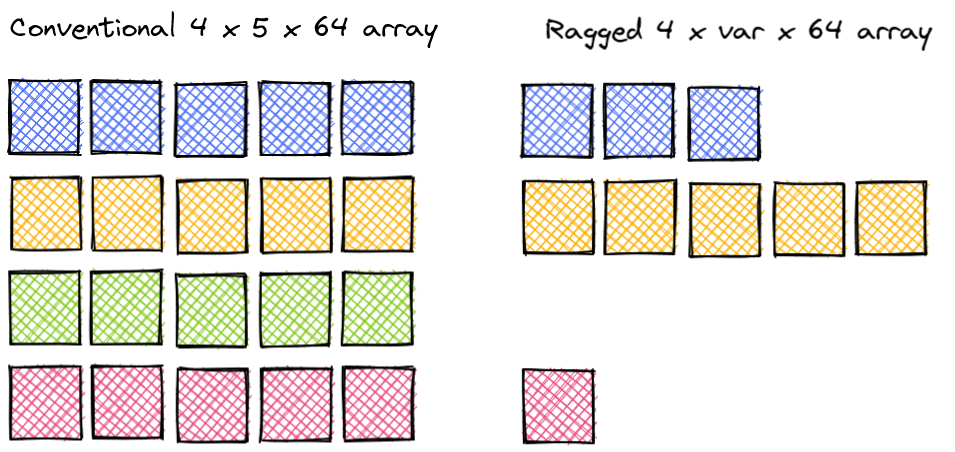9 releases
| 0.4.8 | May 2, 2023 |
|---|---|
| 0.4.7 | Apr 30, 2023 |
| 0.4.3 | Jul 28, 2022 |
| 0.3.8 | Apr 11, 2022 |
| 0.3.7 | Mar 31, 2022 |
#469 in Algorithms
28 downloads per month
Used in entity-gym-rs
79KB
2K
SLoC
ENN Ragged Buffer
This Python package implements an efficient RaggedBuffer datatype that is similar to
a 3D numpy array, but which allows for variable sequence length in the second
dimension. It was created primarily for use in enn-trainer
and currently only supports a small selection of the numpy array methods.

User Guide
Install the package with pip install ragged-buffer.
The package currently supports three RaggedBuffer variants, RaggedBufferF32, RaggedBufferI64, and RaggedBufferBool.
Creating a RaggedBuffer
There are three ways to create a RaggedBuffer:
RaggedBufferF32(features: int)creates an emptyRaggedBufferwith the specified number of features.RaggedBufferF32.from_flattened(flattened: np.ndarray, lenghts: np.ndarray)creates aRaggedBufferfrom a flattened 2D numpy array and a 1D numpy array of lengths.RaggedBufferF32.from_arraycreates aRaggedBuffer(with equal sequence lenghts) from a 3D numpy array.
Creating an empty buffer and pushing each row:
import numpy as np
from ragged_buffer import RaggedBufferF32
# Create an empty RaggedBuffer with a feature size of 3
buffer = RaggedBufferF32(3)
# Push sequences with 3, 5, 0, and 1 elements
buffer.push(np.array([[1, 2, 3], [4, 5, 6], [7, 8, 9]], dtype=np.float32))
buffer.push(np.array([[10, 11, 12], [13, 14, 15], [16, 17, 18], [19, 20, 21], [22, 23, 24]], dtype=np.float32))
buffer.push(np.array([], dtype=np.float32)) # Alternative: `buffer.push_empty()`
buffer.push(np.array([[25, 25, 27]], dtype=np.float32))
Creating a RaggedBuffer from a flat 2D numpy array which combines the first and second dimension, and an array of sequence lengths:
import numpy as np
from ragged_buffer import RaggedBufferF32
buffer = RaggedBufferF32.from_flattened(
np.array([[1, 2, 3], [4, 5, 6], [7, 8, 9], [10, 11, 12], [13, 14, 15], [16, 17, 18], [19, 20, 21], [22, 23, 24], [25, 25, 27]], dtype=np.float32),
np.array([3, 5, 0, 1], dtype=np.int64))
)
Creating a RaggedBuffer from a 3D numpy array (all sequences have the same length):
import numpy as np
from ragged_buffer import RaggedBufferF32
buffer = RaggedBufferF32.from_array(np.zeros((4, 5, 3), dtype=np.float32))
Get size
The size0, size1, and size2 methods return the number of sequences, the number of elements in a sequence, and the number of features respectively.
import numpy as np
from ragged_buffer import RaggedBufferF32
buffer = RaggedBufferF32.from_flattened(
np.zeros((9, 64), dtype=np.float32),
np.array([3, 5, 0, 1], dtype=np.int64))
)
# Get size of the first/batch dimension.
assert buffer.size0() == 10
# Get size of individual sequences.
assert buffer.size1(1) == 5
assert buffer.size1(2) == 0
# Get size of the last/feature dimension.
assert buffer.size2() == 64
Convert to numpy array
as_aray converts a RaggedBuffer to a flat 2D numpy array that combines the first and second dimension.
import numpy as np
from ragged_buffer import RaggedBufferI64
buffer = RaggedBufferI64(1)
buffer.push(np.array([[1], [1], [1]], dtype=np.int64))
buffer.push(np.array([[2], [2]], dtype=np.int64))
assert np.all(buffer.as_array(), np.array([[1], [1], [1], [2], [2]], dtype=np.int64))
Indexing
You can index a RaggedBuffer with a single integer (returning a RaggedBuffer with a single sequence), or with a numpy array of integers selecting/permuting multiple sequences.
import numpy as np
from ragged_buffer import RaggedBufferF32
# Create a new `RaggedBufferF32`
buffer = RaggedBufferF32.from_flattened(
np.arange(0, 40, dtype=np.float32).reshape(10, 4),
np.array([3, 5, 0, 1], dtype=np.int64)
)
# Retrieve the first sequence.
assert np.all(
buffer[0].as_array() ==
np.array([[0, 1, 2, 3], [4, 5, 6, 7], [8, 9, 10, 11]], dtype=np.float32)
)
# Get a RaggedBatch with 2 randomly selected sequences.
buffer[np.random.permutation(4)[:2]]
Addition
You can add two RaggedBuffers with the + operator if they have the same number of sequences, sequence lengths, and features. You can also add a RaggedBuffer where all sequences have a length of 1 to a RaggedBuffer with variable length sequences, broadcasting along each sequence.
import numpy as np
from ragged_buffer import RaggedBufferF32
# Create ragged buffer with dimensions (3, [1, 3, 2], 1)
rb3 = RaggedBufferI64(1)
rb3.push(np.array([[0]], dtype=np.int64))
rb3.push(np.array([[0], [1], [2]], dtype=np.int64))
rb3.push(np.array([[0], [5]], dtype=np.int64))
# Create ragged buffer with dimensions (3, [1, 1, 1], 1)
rb4 = RaggedBufferI64.from_array(np.array([0, 3, 10], dtype=np.int64).reshape(3, 1, 1))
# Add rb3 and rb4, broadcasting along the sequence dimension.
rb5 = rb3 + rb4
assert np.all(
rb5.as_array() == np.array([[0], [3], [4], [5], [10], [15]], dtype=np.int64)
)
Concatenation
The extend method can be used to mutate a RaggedBuffer by appending another RaggedBuffer to it.
import numpy as np
from ragged_buffer import RaggedBufferF32
rb1 = RaggedBufferF32.from_array(np.zeros((4, 5, 3), dtype=np.float32))
rb2 = RaggedBufferF32.from_array(np.zeros((2, 5, 3), dtype=np.float32))
rb1.extend(r2)
assert rb1.size0() == 6
Clear
The clear method removes all elements from a RaggedBuffer without deallocating the underlying memory.
import numpy as np
from ragged_buffer import RaggedBufferF32
rb = RaggedBufferF32.from_array(np.zeros((4, 5, 3), dtype=np.float32))
rb.clear()
assert rb.size0() == 0
License
ENN Ragged Buffer dual-licensed under Apache-2.0 and MIT.
Dependencies
~1.3–7MB
~47K SLoC